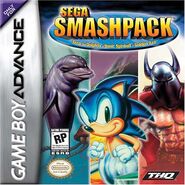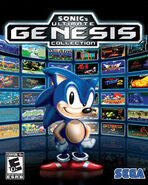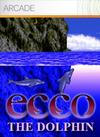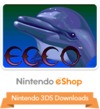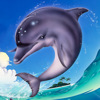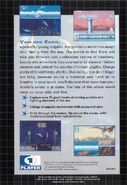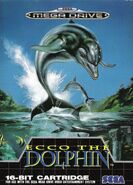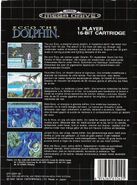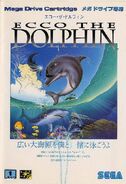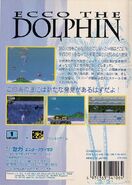(→Trivia) Tags: Visual edit apiedit |
mNo edit summary Tag: sourceedit |
||
| Line 1: | Line 1: | ||
| − | |||
{{Infobox |
{{Infobox |
||
|Box title = Ecco the Dolphin |
|Box title = Ecco the Dolphin |
||
| − | |image = |
+ | |image = File:Ecco cover.png |
| − | |imagewidth = |
+ | |imagewidth = 200 |
| − | |Row 1 title = |
+ | |Row 1 title = Released: |
| + | |Row 1 info = July 29, 1993 (US) |
||
| ⚫ | |||
| + | |}} |
||
| + | |||
| ⚫ | '''Ecco the Dolphin''' is the original video game created by [[Ed Annunziata]] which started the Ecco series. The game was developed for the Sega Genesis console and released in 1992. Additional versions of the game were later released for [[Ecco the Dolphin (Sega CD)|Sega CD]], [[Ecco the Dolphin (Sega Master System)|Sega Master System]], [[Ecco the Dolphin (Sega Game Gear)|Sega Game Gear]], and [[Ecco the Dolphin (Windows)|Microsoft Windows]]. |
||
| + | |||
==Gameplay== |
==Gameplay== |
||
'''Level Structure''' |
'''Level Structure''' |
||
Revision as of 19:02, 2 May 2017
| Ecco the Dolphin | |
|---|---|
 | |
|
Released: |
July 29, 1993 (US) |
Ecco the Dolphin is the original video game created by Ed Annunziata which started the Ecco series. The game was developed for the Sega Genesis console and released in 1992. Additional versions of the game were later released for Sega CD, Sega Master System, Sega Game Gear, and Microsoft Windows.
Gameplay
Level Structure
Most levels consist of having to find and reach the exit. Usually there are obstacles such as Barrier Glyphs that impede the player's progress and have to be removed. In other cases the player will have to solve puzzles or fight a boss.
With the exception of the battle with the Vortex Queen, upon starting a level, the game will give the player a password that can be used to return to that level at any time. With the exception of The Last Fight, the player has infinite continues. All levels are arcade style and must be cleared in one try with no checkpoints present.
Health & Oxygen
The player has two bars to be mindful of: health and oxygen. Running out of health automatically kills Ecco and forces the player to restart the level. Health is depleted upon taking damage from enemies and hazards, while oxygen is generally depleted the longer Ecco stays underwater. If Ecco's oxygen bar runs out, his health bar will begin to deteriorate until he surfaces for air.
Breaching will automatically restore Ecco's oxygen bar, while simply poking his head out of the water will restore his oxygen at a gradual rate. Late in the game, Ecco will be granted Infinite Oxygen by the Asterite. Health can be restored by eating fish, swallowing bubbles from certain Shelled Ones, or singing to an Invincibility Glyph. Late in the game the Asterite will grant Ecco an ability which gradually automatically restores his health, however this ability is unavailable during the fight with the Vortex Queen.
Ecco can be instantly killed by crushing hazards such as moving rocks and chunks of ice, or by being swallowed by the Vortex Queen. Ecco will not take damage while being empowered by an Invincibility Glyph, however he will still be vulnerable to crushing hazards.
Controls
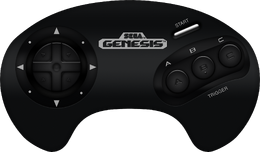
A - Sonar. Advance text.
B - Dash/charge attack.
C - Accelerate swimming speed.
B+A - Charge Sonar (has to be unlocked first).
Directional Pad - Used to move Ecco in 8 directions (Up/Down/Left/Right + diagonals).
Start - Pauses and unpauses game.
Technical Details
While the Genesis console lacked the means to perform many special effects that could be performed on the competing Super Nintendo, Ecco the Dolphin does make use of a lighting system of sorts. When Ecco is above the surface or at varying depths underwater, the colour of his sprite and the overall palette of the level will change slightly to show varying levels of light (at lower levels the coral reefs in the background will become harder to see).
Levels
- 1 Home Bay
- 2 Bay of Medusa
- 3 The Undercaves
- 4 The Vents
- 5 The Lagoon
- 6 Ridge Water
- 7 Open Ocean
- 8 Ice Zone
- 9 Hard Water
- 10 Cold Water
- 11 Island Zone
- 12 Deep Water
- 13 The Marble Sea
- 14 The Library
- 15 Deep City
- 16 City of Forever
- 17 Jurassic Beach
- 18 Pteranodon Pond
- 19 Origin Beach
- 20 Trilobite Circle
- 21 Dark Water
- 22 The Tube
- 23 Welcome to the Machine
- 24 The Last Fight
Story
Development History
Ed Annunziata had difficulty getting Sega to accept his main concept of Ecco the Dolphin as a video game. After pitching the idea repeatedly for over a year to a cold reception, Annunziata eventually decided to transfer to EA for a better paying job. When Sega asked what it would take to keep him at the company, they accepted his request for funds and a team to develop an Ecco prototype. The prototype spent six weeks in development. Upon seeing the prototype, Sega discretely approved the game for full production when it appeared on their product plans. The game spent 10 months in development. Throughout the game's development, Ed repeatedly fought with Sega and won the battle for total creative control.
Development Team:
Producer: Ed Annunziata
Game Design: Ed Annunziata, Laszlo Szenttornyai
Main Programmer: Molnar Joszef
Art: Balogh Zsolt
Music: Spencer Nilsen, Magyari Andras, Brian Coburn
Sales & Sequel
The game became a major seller for Sega in the major video game markets of the time, selling millions of copies. As a result, a sequel was authorized for production, Ecco: The Tides of Time, and was released for the Sega Genesis two years later in 1994.
Trivia
- The Western boxarts for the game were done by Boris Vallejo.
- Ecco name is a reference for the ECCO (Earth Coincidence Control Office), a concept developed by John C. Lily, a neurologist who have made several research and studies on communicarion and sensory that involved dolphins. John C. Lily was a huge influence on the psychedilic movement and the game Ecco the Dolphin has clear psychedilia motives in it.

